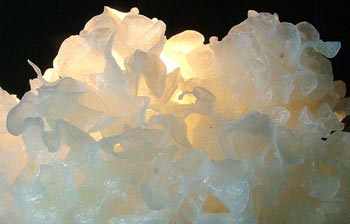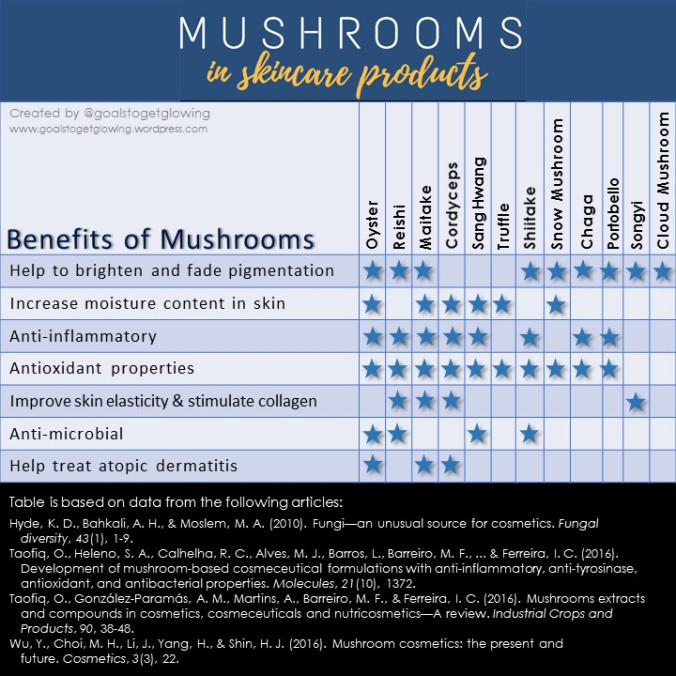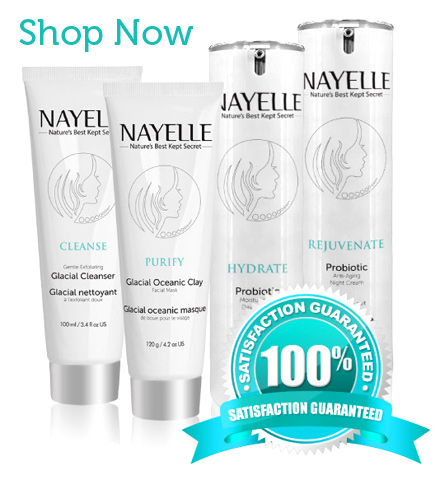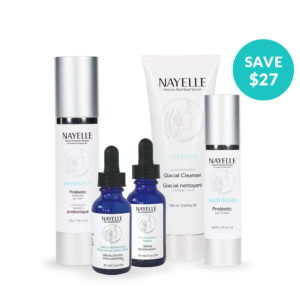The Use of Mushrooms in Skincare

We follow lots of skincare enthusiasts, dermatologists, cosmetic and health experts, and new research on cosmetic ingredients. A newly emerging trend from all these sources is the use of mushroom in skincare products. We have complied an easy to follow guide of all the different types of mushrooms and their uses; focusing the conversation towards skincare products.
In this article we will be covering:
- The benefits of mushrooms
- Types of mushrooms and their unique benefits
Mushroom Benefits
Some incredible research has been done on the benefits of mushrooms. One of our best sources of information on this subject comes from a 2016 study by Taofiq et al. from the Mountain Research Centre.
 The study focuses on mushrooms and their metabolites as important cosmetic ingredients. These doctors of Biotechnological Engineering found that a variety of mushroom extracts and their bioactive metabolites, showed these promising benefits for the skin:
The study focuses on mushrooms and their metabolites as important cosmetic ingredients. These doctors of Biotechnological Engineering found that a variety of mushroom extracts and their bioactive metabolites, showed these promising benefits for the skin:
- Anti‑tyrosinase (Skin Brightening): Some mushrooms have been found to reduce melanin content and inhibit tyrosinase activity (melanin production). Combined, this helps brighten skin and fade pigmentation. Some mushrooms contain kojic acid which is a natural skin lightener. This acid inhibits melanin production on the surface of the skin. This lightens the new skin cells formed after the dead ones are exfoliated.
- Anti‑hyaluronidase (Hydrating): Some mushrooms contains a polysaccharide that is great at hydrating the skin by drawing moisture to the skin, just like hyaluronic acid.
- Anti-collagenase (stimulate collagen synthesis by dermal fibroblasts)
- Anti‑elastase (skin elasticity)
- Antioxidant protection: Some mushrooms hold high antioxidant potential and can help fight free radicals which helps to strengthen the skin’s barrier.
- Antimicrobial
- Anti‑inflammatory: Inflammation and excessive free radical activity contributes to a number of skin problems. Many mushrooms have been found to have anti-inflammatory properties; as a result, their use promotes healing and fights inflammation. Not only do some mushrooms hold anti-inflammatory potential, but mushrooms are high in Vitamin D, which can be healing when applied to acne. Mushroom extracts can be a great ingredient if you are struggling with skin conditions like eczema, rosacea, and acne.
- Anti-aging: Mushrooms enhance the natural defenses of the skin. Mushrooms can help restore the skin elasticity, increase moisture content, stimulate collagen synthesis and have a skin lightening effect–combined this can make the skin look more healthy and have less signs of aging.

Types of Mushrooms and Their Unique Benefits
We have complied a handy list of many of the most common types of mushrooms and their unique benefits. Information on this list was gathered through a variety of research papers on the subject:
Cordyceps sinensis (Cordyceps or Caterpillar fungus)
- Anti-inflammatory
- Moisturizing
- Reported anti-inflammatory potential on skin induced dermatitis
Coriolus versicolor or Trametes versicolor (Cloud mushroom)
- Anti-tyrosinase
Ganoderma lucidum (Reishi or Lingzhi Mushroom)
- Antioxidant
- help repair skin damage associated with over exposure to UV radiation and free radicals.
- Anti-tyrosinase
- Anti-inflammatory
- Best at skin brightening through inhibiting tyrosinase activity
- Anti-aging
Grifola Frondosa (Maitake Mushroom)
- Anti-collagenase and anti-tyrosinase
- High concentration of l-ergothioneine: anti-inflammatory and antioxidant properties
- Reported anti-inflammatory potential on skin induced dermatitis
- Found to inhibit MMP-1
Inonotus obliquus (Chaga Mushroom)
- Anti-tyrosinase
- Antioxidant
Lentinus edodes (Shiitake Mushroom)
- Anti-tyrosinase
- Anti-microbial
- Antioxidant
- Found to induce superoxidase dismutase (SOD) and glutathione peroxidase (GPx), two antioxidant enzymes known for protecting skin from oxidative damage and reversing fibrosis
- Anti-inflammatory, antioxidant
- Can also aid in exfoliation, encourage faster skin renewal, and increase skin elasticity as a skin brightener
- Can produce beta-glucans
Pleurotus species citrinopileatus (Oyster Mushrooms)
- Anti-tyrosinase (Pleurotus species are the most studied mush-room species with reported anti-tyrosinase potential)
- High concentration of the powerful anti-oxidant, l-ergothioneine
- Found to produce beta-glucan
- Anti-hyaluronidase
- Anti-inflammatory
- Reported anti-inflammatory potential on skin induced dermatitis
- Antioxidant
- Anti-microbial
Phellinus linteus (Sang Hwang, Meshima or Meshimakobu Mushroom)
- Anti-inflammatory
- Antimicorbial, anti-inflammatory, antioxidant
- Hydrating via presence of ceramides
Agaricus bisporus (Portobello Mushroom)
- Anti-tyrosinase
- Anti-inflammatory
- Antioxidant and Anti-microbial
Tricholoma matsutake (Songyi or pine mushroom)
- Anti-elastase, anti-collagenase
- Anti-aging potential with ability to prevent degradation of the extra-cellular matrix
- Anti- tyrosinase
Tremella (Snow Mushroom, Golden jelly fungus or yellow trembler)
- Hydrating and skin brightening
- Slightly greater water-holding capacities than HA. One study revealed that cosmetics added with 0.05% Tremella polysaccharides had better moisture retention capacity than that added with 0.02% hyaluronic acid (Liu & He, 2012). This is very popular in China and Japan as a replacement for sodium hyaluronic acid.
- Brightening in a novel effect of inhibiting melanin formation effects and lightening the spots on the skin when applied to the skin
- Tremella reduces the peroxidation of cell lipids and shoots the concentration of Super Oxide Dismutase (SOD) in cells.
Tuber indicum (Truffle Mushroom)
- Contains essential amino acids, vitamins B1, B2 and B3, and polysaccharides such as lentinan and eritadenin; hydrating via presence of ceramides
- Common truffles include e.g. Burgundy truffles (Tuber uncinatum), Perigord truffles (Tuber melanosporum ), Kalahari truffles (Terfezia pfeilii Hennings), Piedmont truffles (Tuber magnatum Pico Vitt.), lion’s truffles (Terfezia leonis Tul.), summer truffles (Tuber aestivum), winter truffles (Tuber brumale Vitt.) and white truffles (Choiromyces maeandriformis).
This table was created by our friend Vanessa, at Goals to Get Glowing. These values are based on studies reviewing the cosmeceutical potential of mushroom extracts. More in vivo and clinical studies are needed to develop and validate cosmeceutical formulations with mushrooms.



